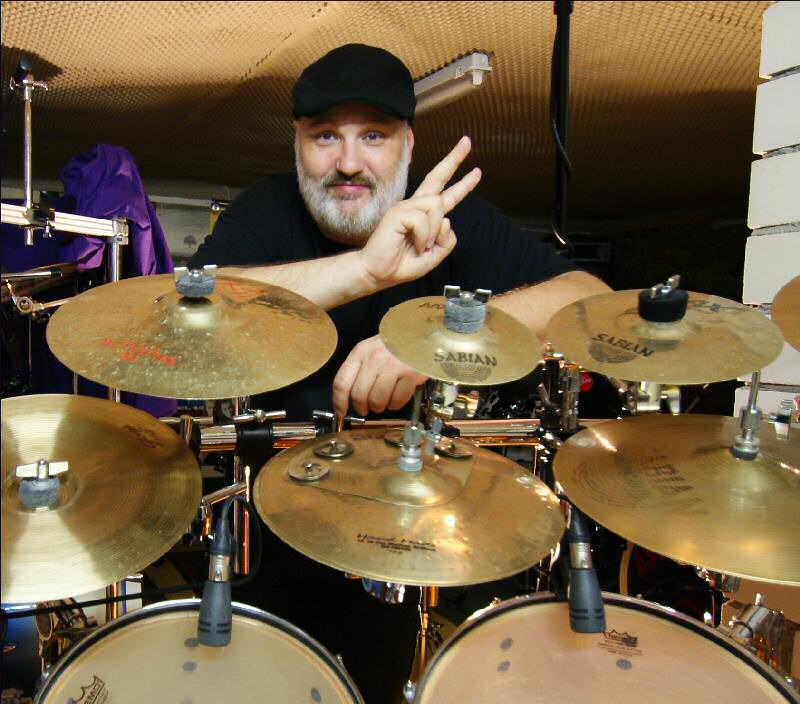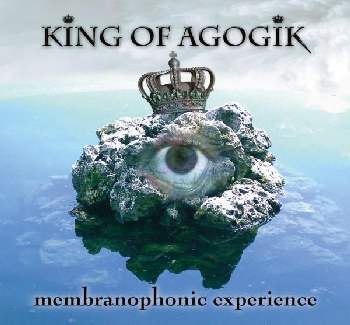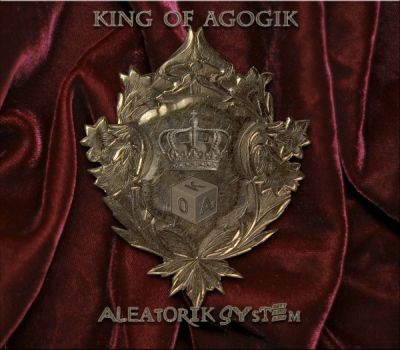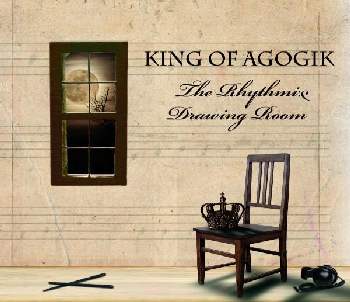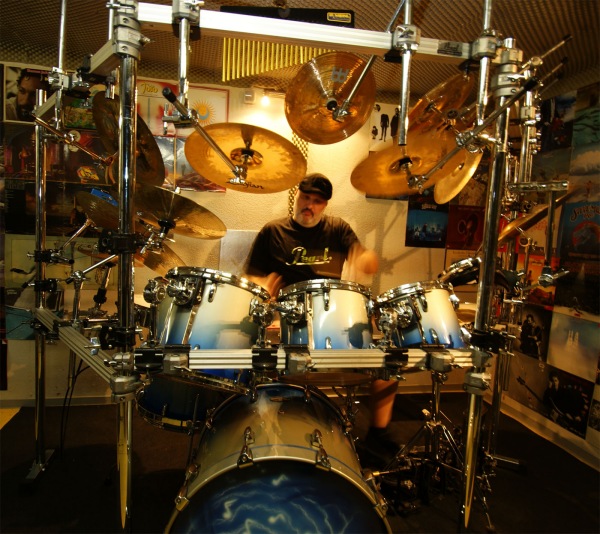K.o.A. is not a band, but for me it is much more then a normal project.
For more information:
*Agogik* ist die *Kunst der Tempoveränderung*
*King of Agogik* ist mein Soloprojekt und ich spiele neben dem Schlagzeug noch
Keyboards, ein wenig Gitarre und wenn es sich gar nicht vermeiden läßt, auch Bass.
Außerdem sind befreundete Musiker in das Projekt involviert.
“Membranophonic Experience” wurde 2006 als erste “King of Agogik” CD
veröffentlicht. In der Schlagzeuger-Fachzeitschrift “Sticks” (01/07)
wurde die Platte zur CD des Monats gewählt und es gab einen Workshop
mit Notenmaterial im Heft. In der Märzausgabe 2007
folgte dann ein mehrseitiges Interview.
2008 folgte dann “Aleatorik System”. Im Mai 2008 gab es erneut einen
Workshop mit Notenmaterial bei “Sticks” und
wieder wurde die Platte zur CD des Monats gekürt.
Auch bei „The Rhythmic Drawing Room“ reißt die Serie nicht ab.
Im Februar 2010 ist die Doppel-CD ebenfalls Platte des Monats bei Sticks
2011 erblickte “From A to A” die Welt, ein Konzeptalbum über Andernach.
Positive Besprechungen aus aller Welt folgten…
November 2014 erschien “EXLEX BEATS”,
im Januar 2017 das Album #6 “Morning Star”.
Die bisher letzte KoA-Veröffentlichung “After the last Stroke” war im April 2019,
die Arbeiten am achten Album ” The undanceable encore ” haben begonnen….
Read this interview to get an overview
(from Background Magazin – NL):
|
On Go Where The Pepper Grow I heard The Beatles. Is it a tribute to them? “This piece of music starts with a rare version of Sgt. Pepper, although supplemented by my drums and the guitar of Dirk ‘Dago’ Wilms. I was and still am a big fan of The Beatles and John Lennon is acoustically represented on my four King Of Agogik-albums. The remainder of this piece is, among others, a number of things which I found aggravating. Because of that they should just go there where the pepper grows. It’s a typical German phrase and therefore hard to translate. The English equivalent would be something like ‘jump into the lake’. Analyzing by just the word ‘pepper’ is senseless.”
The album shows a musician who has found a musical style of its own. Do you agree? “In my opinion this is a natural process, a further development that happens without any conscious influence and hopefully causes some progress to the whole project.” The credits mention AMC Choir Miami. Did you use a choir on the album and what was the reason? “While my wife and I visited the United States of America we attended a mass in Miami. Usually you expect that coloured people have music in their genes, but the AMC Choir was more of a disappointment. Therefore I used only a short recording of the choir later on to incorporate on the album…” Your previous album is called The Rhythmic Drawing Room (2009). What is it exactly and why did you use this title? “The original idea has been taken from the Crimson Drawing Room, the saloon of the Queen in which she receives her guests and in which many images, mostly canvases, can be found. In my ‘rhythm’ living room I invite my guests on a more mental level. The pictures in the digipack do all have a link to the album. For example, there is Ostia the old harbour of Rome or John Cleese from Monty Python and Mad Hatter, the figure on the label of record company Charisma.”
On Prog ‘n’Roll I heard the sound of a live audience. I guess it was taped somewhere or was the music really performed in front of an audience? “The sound of an audience is mixed in from live records from the bands I’ve played in. Prog’n’ Roll was never played in front of an audience.” The inside cover of The Rhythmic Drawing Room reminded me of Pictures At An Exhibition by ELP. Do you agree? “In the beginning I had another intention for the cover (see above), but months earlier a project had been planned, in which the compositions of Mussorgsky – that ELP didn’t play – should have been completed. Maybe this event influenced my subconsciousness.” Do you consider your latest album From A To A to be your best album so far? “In fact the latest album should always be the best one, but with the passing of time you get a more differentiated view on your own work. You then get the chance to take a step back and look at the things you’ve done. I think all four albums have their strengths and weaknesses and naturally my focus is on the next album. However, regarding the sound of From A To A this album is the best one so far.”
On From A To A you mentioned Amsterdam, Vancouver, Cambridge, Tingsryd, Bonn and Friedrichsdorf in the credits. Why did you mention these cities? “These are the places where the people live that did some recordings and sent them back to me via the internet. At Friedrichsdorf, nearby Frankfurt, lives Michael Elzer who is the ‘stickist’ so to say. In Bonn lives guitarist Dago Wilms. I went personally to these two guys to do the recordings. This also applies for keyboardist Erik Vaxjö. The recordings for the drums I did at home.” Erik Vaxjö played the Mellotron, but did you play it yourself as well this time? “The Mellotron is probably one of the most beautiful instruments and I’d like to have one. Erik’s got a real M400, but I work with the VST Plug-in.” Is Blue Tears a song about World War II? “It is, in a way. It’s about personal experiences and my feelings about war and the Holocaust. The language on Blue Tears is Yiddish spoken by Gernot Jonas, a protestant priest at Andernach. He’s one of the few persons in the world who still speaks this language. For example, he is translating books from Yiddish to German. He also travels through Europe in order to stay in contact with the few people left who also speak this language. The words on Blue Tears haven been derived from the Partisan song Sag Nit Kejnmol. The title Blue Tears refers to little sparkling pieces of blue glass, but to understand this I have to give you some background information. In 1938 the synagogue of Andernach – the picture can be seen in the booklet – was destroyed by the nazis. The ruin of the building was dormant for a couple of years. Later on a regional building enterprise built a house upon the ruin and my parents settled in. My bed stood at the same place as the former altar and nearby the house there was a sandbox. When my friends and I digged deeper than seventy centimeters we sometimes found blue and shimmering little treasures. Only after years I heard about the windows and the mosaic floor of the synagogue that were made of the material we had found. Many tracks on From A To A are based on such personal stories and have a relation with Andernach. Thanks On High Street is a good example of the things I did and at the same time unmasks me being a thieve. The picture in the booklet has been shot on March 9, 1945, the thirteenth birthday of my mother who at the time lived nearby. The American army liberated Andernach while driving their tanks through High Street. With this regard High Street, or Hochstraße in German, is a pun. The British band The Stranglers released in 1978 an album called Black And White, the only punk album ever I bought myself. On this album the hugely distorted bass sound is very dominant. This sound I wanted to have for my album, but not as a sample. So I set down and played bass for two days in order to produce exactly the same sound and thus the strong related feeling. And not to forget, the hooter you hear at the recording is the one from Andernach. It’s still howling every Monday at five o’clock in the afternoon to prevent her from getting rusty. Michael Kreutz, the guy who played the bass on one track, has recorded it for me.” Thanks for this extensive explanation. On From A To A you used a musical part of Popcorn, a song written by Gershon Kingsley and mostly known as the instrumental dance hit by Hot Butter in 1972. Are you free to use this kind of fragments without paying royalties? “Yes, everything under twelve bars is absolutely legal.” I saw that you dedicated the album to Hermann Schmitz. Is he a relation of yours? “Yes, he’s my father. He died in 1991.” Will you ever release a vocal album or an album on which the drums are mixed less up front? “I probably will, but under another name. The idea is running through my head, because I know a few good singers and the whole thing stirs me up a bit. I think the musical structure would probably change in order to become more real compositions.”
Since 2006 you already released four albums of which one of them is a double album. Do you have so much inspiration or what? “As I said I’m kind of foolish and my head is filled with many ideas. I also spent many hours a day with music and drumming. Unfortunately the variety and diversity is too much for some people. It can happen that you feel strained while listening to the music for the first time, but after being through the album five times it’ll get better and better.” Do you ever think of performing your music on a live stage or is King Of Agogik just a studio project? “King Of Agogik is and will probably stay a studio project.” Your music is very cleverly made and enjoyable for lovers of prog rock. Nevertheless the music sometimes tends to sound alike. Do you realize this and do you try to avoid this on your next albums? “Naturally I reuse some of my sound and chord preferences, but I hoped that I didn’t reach this point yet. Of course, I keep trying to create something new, something of my own.” Would you name the musicians that influenced you most and would you like to record or play with them? “Everything started with The Beatles and then it went on with Genesis, Yes, Mike Oldfield and so on. From Genesis alone I own over 250 CDs with all sorts of stuff: live recordings, recordings from the studio or the practice room, simply awesome. Sometimes it thrills me more than a good thriller. Phil Collins was one of the best musicians and drummers of the seventies and eighties. On Aleatorik System I’ve recorded a tribute to him named Call In S. As a young drummer I went for all I could reach for. Fortunately there were drummer meetings in the area so I got the chance to listen to professionals and getting in touch with them. Today I’m beyond the higher-faster-further-attitude. I respect the achievements of other people and I enjoy it.” What are your future plans? “Well, I would like to stay healthy and satisfied and I hope to create some good music a couple of years longer.” Would you please say a final word to our readers and how they can in touch with your music? “First of all I’d like to thank you, the interviewer. Only by people with real interests in new, honest and non-commercial things, you enable further development. To all I would say: stay calm and try something new like at the dinner table. Tackle problems with an open mind and invest some time in it; maybe the results reward your efforts. Otherwise it still applies that every end carries a new beginning.” Thank you for this interview. “You’re welcome.” |

